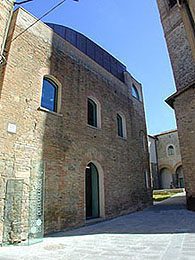Il Museo della Ceramica di Deruta rappresenta uno dei punti di interesse storico ed artistico più significativi del comprensorio. Si tratta infatti del più antico museo italiano in assoluto dedicato alla ceramica, istituito nel lontano 1898 nel palazzo comunale e poi trasferito nell’attuale sede. Nel corso degli anni, il museo è stato arricchito con nuove acquisizioni, fino a raggiungere l’attuale numero di circa 6000 opere esposte.
A rendere ancora più unico il museo è certamente la sua collocazione: dal 1998 il museo è infatti ospitato all’interno dell’ex Convento di San Francesco, un edificio trecentesco completamente restaurato situato nel cuore del centro storico di Deruta. L’edificio si articola su tre piani e si estende per un’area di 1700 mq, contando un totale di 14 sale espositive. Il percorso museale comprende anche l’imponente struttura riservata ai depositi e l’area archeologica di San Salvatore.
Andiamo allora alla scoperta di questo luogo tutto da esplorare!
Museo Regionale della Ceramica, Deruta
Le opere conservate all’interno del museo sono esemplari magnifici di Ceramiche e Maioliche di Deruta realizzate nel corso di decenni dai maestri artigiani locali. Curato da Giancarlo Bojani e Giulio Busti, il progetto di allestimento prevede un percorso museale che costituisce un viaggio cronologico attraverso questa produzione, mettendone in evidenza l’evoluzione dal periodo arcaico fino al Novecento. Particolarmente interessanti sono le aree tematiche, dove è stata realizzata un’istallazione che ricostruisce un’antica spezieria e dove si trovano collezioni integrali, sezioni di pavimenti in maiolica, ceramica a lustro e targhe votive.
Si segnala che la maggior parte delle opere presenti nelle sale dedicate al periodo contemporaneo, provengono dal Multiplo d’Artista in Maiolica e dal Premio Deruta.
Di seguito il dettaglio delle singole sale che compongono il museo, dal piano terra salendo fino al secondo piano:
- Piano Terra – ospita vari esemplari di di terrecotte invetriate, la cui produzione era in passato diffusa in tutto il territorio dell’Umbria:
- Sala dei Maestri del Novecento;
- Sala Didattica;
- Sala dei frammenti e della maiolica arcaica;
- Sala dei Depositi.
- Primo Piano – ospita il pavimento della chiesa di San Francesco, ritrovato nel 1902, costituito da circa duecento piastrelle e considerato una delle opere più importanti realizzate dai pittori derutesi:
- Sala dei Pavimenti;
- Sala dei Depositi.
- Secondo Piano: raccoglie diversi esemplari di ceramiche e maioliche derutesi suddivise per epoche a testimoniare la storia e il gradule cambiamento nell’arte della ceramica da parte degli artigiani locali:
- Sala del Rinascimento;
- Sala del compendiario;
- Sala delle “grottesche” e del “calligrafico”;
- Sala del Settecento;
- Sala Collezione Milziade Magnini;
- Sala della farmacia;
- Sala dei depositi.
Vediamo ora i due ambienti aggiuntivi che caratterizzano il Museo.
I Depositi del Museo di Deruta
I depositi del Museo costituiscono un ambiente unico nel loro genere, poiché sono collocati all’interno di una struttura metallica molto imponente che si sviluppa su ben 4 piani, adiacenti all’impianto conventuale e comunicante con questo a tutti i livelli. I piani dei depositi ospitano scaffali vetrati colmi di opere, per un totale di circa 4500 ceramiche. I depositi sono sempre accessibili al pubblico e sono attrezzati per organizzare attività di studio e didattiche, oltre a laboratori a tema.
Nel suo complesso, il Museo della Ceramica costituisce infatti una fonte d’eccellenza per la documentazione in materia, un archivio territoriale interamente fruibile di grande valore.
Area Archeologica di San Salvatore
Questa è l’area che più di recente è entrata a far parte del percorso museale: si tratta infatti di un’antico sito archeologico riportato alla luce nel 2008. Nel corso di alcuni lavori di realizzazione di un parcheggio a ridosso delle mura dell’edificio, sono stati ritrovati i resti di quella che era l’antichissima Chiesa di San Salvatore, una scoperta di grande valore storico-artistico.
Gli archeologi hanno infatti recuperato delle strutture databili tra la fine del Duecento e i primi del Settecento, oltre a recuperare un grande numero di reperti: ceramiche di vario genere, maioliche, terrecotte invetriate. A giustificazione di questi oggetti, sono state rinvenute ben due fornaci che risalgono alla fine del XIV secolo e la prima metà del XV, entrambe con prefurnium ben conservato. Una delle due fornaci è collocata in una posizione rialzata rispetto all’altra e presenta una forma quadrata, a differenza della principale che è più grande e di forma circolare. Gli studiosi ipotizzano che questa fornace più piccola fosse adibita alla produzione della ceramica a lustro.
Museo della Ceramica: orari e biglietti
Se volete organizzare la vostra visita al Museo, ecco tutte le informazioni che utili:
Giorni e Orari di apertura
NOVEMBRE – MARZO
da giovedì a Lunedì
10.00-17.00Chiuso Martedì e mercoledì
Su prenotazione, è possibile concordare aperture straordinarie del sito con visite guidate in italiano e in inglese.
Biglietti di ingresso al museo
INTERO 7 €
RIDOTTO A 5 € (gruppi di almeno 15 unità)
RIDOTTO B 2 € (da 6 a 14 anni)
OMAGGIO (fino a 5 anni, disabili con accompagnatore, guide turistiche abilitate, giornalisti accreditati, soci Icom, residenti)
La biglietteria chiude mezz’ora prima della chiusura del Museo.
“Ceramisti per un giorno”
Dopo il tour guidato i visitatori potranno decorare un manufatto in maiolica con la famosa e antica tecnica dello “spolvero”
La durata di questa attività è di cica 2 ore. Si può effettuare la decorazione di una mattonella (10×10) al costo €10,00 a partecipante; oppure si può decorare un piattino al costo di €15,00 a partecipante. Al costo dell’attività dovrà essere aggiunto il costo del biglietto di ingresso al museo.
Attività su prenotazione, con un giorno di anticipo (075/9711000).
Il Museo Regionale della Ceramica di Deruta fa inoltre parte del Circuito delle Terre e Musei dell’Umbria, che comprende 16 musei situati in 12 comuni umbri visitabili grazie ad un unico biglietto legato al circuito stesso.
Buona visita al Museo Regionale della Ceramica da Bella Umbria!



Comment (0)